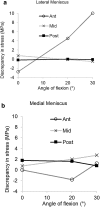Predicting meniscal tear stability across knee-joint flexion using finite-element analysis
- PMID: 30097687
- PMCID: PMC6510819
- DOI: 10.1007/s00167-018-5090-4
Predicting meniscal tear stability across knee-joint flexion using finite-element analysis
Abstract
Purpose: To analyse the stress distribution through longitudinal and radial meniscal tears in three tear locations in weight-bearing conditions and use it to ascertain the impact of tear location and type on the potential for healing of meniscal tears.
Methods: Subject-specific finite-element models of a healthy knee under static loading at 0°, 20°, and 30° knee flexion were developed from unloaded magnetic resonance images and weight-bearing, contrast-enhanced computed tomography images. Simulations were then run after introducing tears into the anterior, posterior, and midsections of the menisci.
Results: Absolute differences between the displacements of anterior and posterior segments modelled in the intact state and those quantified from in vivo weight-bearing images were less than 0.5 mm. There were tear-location-dependent differences between hoop stress distributions along the inner and outer surfaces of longitudinal tears; the longitudinal tear surfaces were compressed together to the greatest degree in the lateral meniscus and were most consistently in compression on the midsections of both menisci. Radial tears resulted in an increase in stress at the tear apex and in a consistent small compression of the tear surfaces throughout the flexion range when in the posterior segment of the lateral meniscus.
Conclusions: Both the type of meniscal tear and its location within the meniscus influenced the stresses on the tear surfaces under weight bearing. Results agree with clinical observations and suggest reasons for the inverse correlation between longitudinal tear length and healing, the inferior healing ability of medial compared with lateral menisci, and the superior healing ability of radial tears in the posterior segment of the lateral meniscus compared with other radial tears. This study has shown that meniscal tear location in addition to type likely plays a crucial role in dictating the success of non-operative treatment of the menisci. This may be used in decision making regarding conservative or surgical management.
Keywords: Arthroscopy; Biomechanics; Finite element analysis; Knee; Meniscal tear; Meniscus; Reconstruction; Repair; Surgery.
Conflict of interest statement
Conflict of interest
The authors declare that they have no conflict of interest.
Ethical approval
This article does not contain any studies with human participants or animals performed by any of the authors.
Figures







References
Publication types
MeSH terms
LinkOut - more resources
Full Text Sources
Other Literature Sources
Miscellaneous

